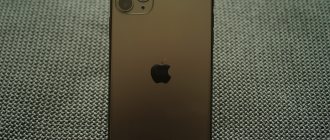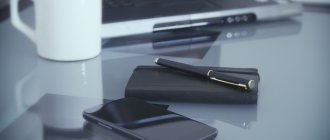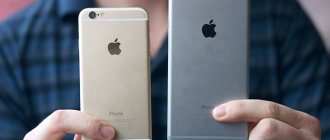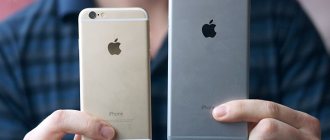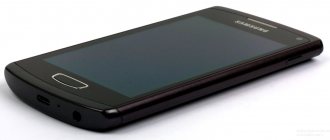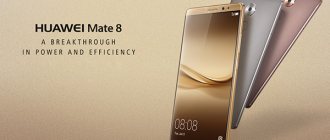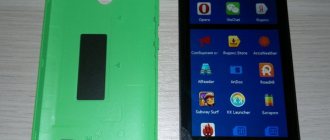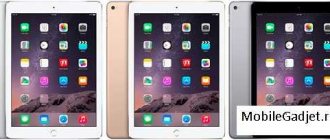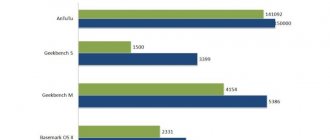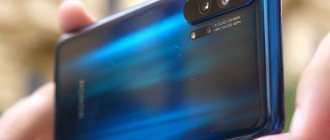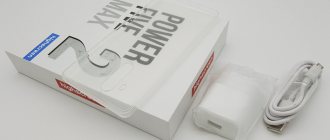Size, thickness and weight
| iPhone 8 Plus | iPhone 8 | |
| Screen diagonal, inches (one inch is 2.54 cm) | 5.5 | 4.7 |
| Length, cm | 15.84 | 13.84 |
| Width, cm | 7.81 | 6.73 |
| Thickness, cm | 0.75 | 0.73 |
| Weight, gram | 202 | 148 |
If you use your phone more often to browse social networks than to make calls, then it is better to choose a smartphone with a larger screen diagonal. The iPhone 8 Plus has a bigger one. At the same time, the iPhone 8 has a thinner body and less weight.
The display is nothing new. Practically...
There's nothing new about the iPhone 8 Plus screen. Unless they added support for True Tone technology. The bottom line is that a special sensor next to the front camera monitors the ambient light and adjusts the temperature of the screen colors to a specific situation. In short, the screen becomes either very yellow (in a room with low lighting) or slightly yellowish (in bright sun).
And no, this is not Night Shift. This setting works separately. If, of course, you activate it.
I compared the screens of the iPhone 8 Plus and the regular eight. That's what came out of it.
If you compare it head-on, it becomes obvious that the 8 Plus display renders colors a little more pleasantly. The youngest ones are sharper and have a slight green tint.
A strong deviation along the diagonal axis shows that this is a very ordinary IPS matrix. Yes, it’s high quality, no doubt about it, but it still floats like a whitish fog. This is not AMOLED.
Apple tirelessly claims that the screen here is “Retina HD”, that it is new and all redesigned, that it supports the expanded P3 color gamut and all that, but in reality the display easily compares to some OnePlus 5 with its Optic AMOLED.
Screen
| iPhone 8 Plus | iPhone 8 | |
| Display name | Retina HD | Retina HD |
| Display Description | 5.5" widescreen Multi-Touch LCD with IPS technology | 4.7" widescreen Multi-Touch LCD with IPS technology |
| Screen resolution, pixels | 1920×1080 | 1334×750 |
| Pixels per inch | 401 | 326 |
| Contrast | 1300:1 | 1400:1 |
| Maximum brightness, cd/m² | 625.0 | 625.0 |
Who will we give preference to? We come to the conclusion that the iPhone 8 has slightly better screen contrast, the 8 plus is ahead in display size and resolution.
↑ Dimensions of iPhone 8
Like its predecessor, the iPhone 8 has a 4.7-inch screen, and it is almost impossible to distinguish them by the front panel. The height of the updated model is 13.4 cm, width 6.7, and thickness 0.73 cm. For comparison, the 2020 iteration is 0.02 cm thicker due to the use of impact-resistant glass on the front and back of the case. For the same reason, it became heavier by as much as 10 grams.
The iPhone 8 has also become a little taller and wider, but this does not prevent the use of cases and other accessories from its predecessor. Keep in mind that if your 7 case has an apple cutout, it will not fit, as the engineers have slightly changed the position of the logo on the back.
Processor, memory and battery
| iPhone 8 Plus | iPhone 8 | |
| Processor name | Apple A11 Bionic | Apple A11 Bionic |
| CPU frequency | 2.4 GHz | 2.4 GHz |
| Memory |
|
|
| Battery life | ||
| During conversation | until 21 o'clock | until 14 o'clock |
| In the Internet | until 13 o'clock | till 12 o'clock |
| When listening to audio | up to 60 hours | up to 40 hours |
The phones use the same processor – A11 with a clock frequency of 2.4 GHz. iPhone 8 Plus on a single charge can last much longer than iPhone 8 – up to 60 hours when listening to audio. The iPhone 8 failed to compete in this comparison.
Review of the Apple iPhone 8 Plus smartphone: testing and use experience
The iPhone X was in the spotlight last year, and we didn't ignore it: read our articles here and here. In addition, we told you about the compact iPhone 8 model. But next to these two new products, the iPhone 8 Plus has faded into the background, which seems to be not quite a flagship, but at the same time cannot boast of the compactness and attractive price of the iPhone 8. However, it would be wrong to completely discount him. That's why we decided to use the iPhone 8 Plus in real life and talk about our impressions of it - both in comparison with the iPhone X and the iPhone 7 Plus. But, of course, you will also find traditional test results in the article.
Let's take a look at the characteristics of the new product.
Technical specifications of Apple iPhone 8 Plus
- SoC Apple A11 Bionic (6 cores, 2 of which are high-performance and operate at 2.1 GHz, and 4 are energy-efficient)
- Apple A11 Bionic GPU
- Apple M11 motion coprocessor including barometer, accelerometer, gyroscope and compass
- RAM 3 GB
- Flash memory 64 / 256 GB
- No memory card support
- Operating system iOS 11
- IPS touch display, 5.5″, 1920×1080 (401 ppi), capacitive, multi-touch, support for 3D Touch technologies and Taptic Engine response
- Cameras: front (7 MP, video 1080p 30 fps, 720p 240 fps) and rear with two lenses (12 MP, optical zoom 2×, video shooting 4K 60 fps)
- Wi-Fi 802.11b/g/n/ac (2.4 and 5 GHz; MIMO support)
- Cellular: UMTS/HSPA/HSPA+/DC-HSDPA (850, 900, 1700/2100, 1900, 2100 MHz); GSM/EDGE (850, 900, 1800, 1900 MHz), LTE Bands 1, 2, 3, 4, 5, 7, 8, 12, 13, 17, 18, 19, 20, 25, 26, 27, 28, 29, 30, 38, 39, 40, 41, LTE Advanced support
- Bluetooth 5.0 A2DP LE
- Touch ID fingerprint scanner version 3
- NFC (Apple Pay only)
- Universal Lightning Connector
- Supports Qi wireless charging
- Li-polymer battery 2675 mAh, non-removable
- GPS / A-GPS, Glonass
- Dimensions 158×78×7.5 mm
- Weight 202 g
For clarity, let’s compare them with the iPhone 8 and iPhone 7 Plus to understand, firstly, how the two generations of larger Apple smartphones differ, and secondly, whether there is a difference between the two new generation models (besides the size, of course).
| Apple iPhone 8 Plus | Apple iPhone 7 Plus | Apple iPhone 8 | |
| Screen | 5.5″, IPS, 1920×1080, 401 ppi | 5.5″, IPS, 1920×1080, 401 ppi | 4.7″, IPS, 1334×750, 326 ppi |
| SoC (processor) | SoC Apple A11 Bionic (6 cores, 2+4) | Apple A10 Fusion (4 cores, 2+2) | SoC Apple A11 Bionic (6 cores, 2+4) |
| Flash memory | 64/256 GB | 32/128/256 GB | 64/256 GB |
| Connectors | universal lightning connector | universal lightning connector | universal lightning connector |
| Memory card support | No | No | No |
| RAM | 3 GB | 3 GB | 2 GB |
| Cameras | main (12 MP; video 4K 60 fps) with two lenses and front (7 MP; shooting and transmitting Full HD video) | main (12 MP; video 4K 30 fps) with two lenses and front (7 MP; shooting and transmitting Full HD video) | main (12 MP; video 4K 60 fps) and front (7 MP; shooting and transmitting Full HD video) |
| User identification sensors | Fingerprint's scanner | Fingerprint's scanner | Fingerprint's scanner |
| Housing protection | IP67 (water and dust protection) | IP67 (water and dust protection) | IP67 (water and dust protection) |
| Battery capacity (mAh) | 2675 | 2900 | 1821 |
| operating system | Apple iOS 11 | Apple iOS 10 (upgrade to iOS 11 available) | Apple iOS 11 |
| Dimensions (mm) | 158×78×7,5 | 158×78×7,3 | 138×67×7,3 |
| Weight (g) | 202 | 189 | 148 |
| Average price (for version with minimum flash memory) | find out prices | find out prices | find out prices |
| Apple iPhone 8 Plus (64GB) Retail Deals | find out the price | ||
| Apple iPhone 8 Plus (256GB) Retail Deals | find out the price | ||
The main difference between the larger new iPhone and its younger brother (besides the size and display area, of course) is 3 GB of RAM instead of 2 GB. We'll talk about how this affects performance further. As for the comparison with the iPhone 7 Plus, it’s worth paying attention to the new 4K 60 fps video shooting mode (the “seven” only had 4K 30 fps), as well as the slightly reduced battery capacity. However, it is too early to draw any conclusions from this - we need to look at it in practice.
Well, let's get acquainted with the smartphone live.
Packaging and equipment
The iPhone 8 Plus is completely identical to its younger brother, the only difference is in size. And in size, it, in turn, is completely identical to the iPhone 7 Plus - so much so that even the cases will fit.
However, using a case with the iPhone 8 Plus is a dubious idea, because you won’t feel like you’ve upgraded to a new iPhone if you previously had an iPhone 7 Plus. Of course, the main innovation in terms of design is the glass back surface.
It must be said that in addition to the obvious aesthetic advantages, it also has an important practical advantage: it is much less scratched than the Jet Black coating on the iPhone 7 Plus. In less than a year of use, our iPhone 7 Plus Jet Black is already covered in scratches, although the smartphone was in a case for the vast majority of this period. In the case of the iPhone 8 Plus, after a month of equally active use in everyday life, no visible damage appeared - not even the smallest scratch, although it was not always in a case.
At the same time, it is quite obvious that the case reduces the likelihood of breaking the smartphone and allows it to maintain its “marketable” appearance longer. So the question of whether to use a case or not remains open. By the way, Apple has also released new cases for the new iPhones: in the photo below there is an iPhone 8 Plus in a charcoal gray leather case.
As for the colors of the smartphone itself, as you know, the iPhone 8/8 Plus is sold in three color options - silver, gold and space gray. Pink is no longer in the assortment, as well as Jet Black. But the gold version that we used gives a noticeable pinkish tint. This is an amateurish effect, although a very interesting one. The other two colors are more versatile.
There's another benefit to the glass back (or at least that's what Apple claims): the new iPhones support wireless charging. We mentioned this in our review of the iPhone 8, but now we decided to check how this works in practice.
Wireless charging iPhone 8 Plus
Unfortunately, Apple has not yet released a proprietary AirPower charging station, so you have to use third-party solutions.
The iPhone 8 Plus (as well as the iPhone 8 and iPhone X) support the Qi standard. This is the most popular wireless charging standard, so if you see a wireless charger in a store, it will most likely be a suitable option.
As it turns out, finding inexpensive wireless chargers in retail is not easy. The author went into a number of large chain stores near the central stations of the Moscow metro and everywhere encountered bewildered sellers. At first they did not understand what wireless charging was in principle, then some of them recalled that “it seems we have it, but only for Samsung phones” (they had to explain that it would also work for the iPhone), but in the end it turned out that the only option costs about 4,000 rubles, and the desire to buy it immediately disappeared.
However, if we go to the websites of the same stores, we can easily find many more attractive offers. Prices start from 1000 rubles. True, the charger really needs to be ordered - either for delivery by courier, or for pickup from some store. Apparently they are not in enough demand to put them on the shelves.
So, we decided to try one of the cheapest options - Buro Q5 - and measured how long it takes to charge the iPhone 8 Plus.
The result was not very happy: in half an hour, a heavily discharged iPhone is charged by about 12%. In total, the process will take at least four hours. Here, however, it should be noted that the current strength of the Buro Q5 is 1 A. Of course, there are 2 A wireless chargers on sale, but there are much fewer of them than single-amp ones, and their price starts from 2,000 rubles.
In general, if you want to use third-party wireless charging, you can do it, and there should be no problems, but be prepared for slow charging, or look for two-amp charging and pay much more for it.
Screen
The screen parameters of the iPhone 8 Plus are no different from those of the iPhone 7 Plus: 5.5-inch diagonal, IPS matrix with a resolution of 1920×1080. By modern standards, these are far from record parameters. However, as we know, screen quality is not determined by resolution alone. On top of that, the manufacturer has introduced a number of interesting technologies into new generation screens.
Alexey Kudryavtsev, editor of the “Monitors” and “Projectors and TV” sections, will tell you about the quality of the display.
.
The front surface of the screen is made in the form of a glass plate with a mirror-smooth surface that is scratch-resistant. Judging by the reflection of objects, the anti-glare properties of the screen are better than those of the Google Nexus 7 (2013) screen (hereinafter simply Nexus 7). For clarity, here is a photo in which a white surface is reflected when the screens are turned off (on the left is Nexus 7, on the right is Apple iPhone 8 Plus, then they can be distinguished by size):
The screen of the Apple iPhone 8 Plus is slightly darker (brightness according to photographs is 104 versus 113 for the Nexus 7). The ghosting of reflected objects in the screen of the Apple iPhone 8 Plus is very weak, this indicates that there is no air gap between the layers of the screen (more specifically, between the outer glass and the surface of the LCD matrix) (OGS - One Glass Solution type screen). Due to the smaller number of boundaries (glass/air type) with very different refractive indices, such screens look better in conditions of intense external illumination, but their repair in the case of cracked external glass is much more expensive, since the entire screen has to be replaced. The outer surface of the screen has a special oleophobic (grease-repellent) coating (effective, much like the Nexus 7), so fingerprints are removed much more easily and appear at a lower speed than with regular glass.
With manual brightness control and when the white field was displayed in full screen, the maximum brightness value was about 580 cd/m², the minimum was 2.7 cd/m². The maximum brightness is very high, and, given the excellent anti-glare properties, screen readability even on a sunny day outdoors will be at a good level. In complete darkness, the brightness can be reduced to a comfortable value. There is automatic brightness adjustment based on the light sensor (it is located above the front speaker slot), which is enabled by default. In automatic mode, as external lighting conditions change, the screen brightness both increases and decreases. The operation of this function depends on the position of the brightness adjustment slider - the user uses it to set the desired brightness level for the current conditions. If you don’t change anything, then in complete darkness the brightness drops to 3.0 cd/m² (very dark), in an office illuminated by artificial light (about 550 lux) the screen brightness is set to 100-160 cd/m² (acceptable), and in in a very bright environment (corresponding to lighting on a clear day outdoors, but without direct sunlight - 20,000 lux or slightly more) rises to 670 cd/m² (even higher than with manual adjustment). We were not entirely satisfied with the result, so in the dark we slightly moved the brightness slider to the right and for the three conditions indicated above we received 15, 120 and 670 cd/m² (ideal). It turns out that the auto-brightness function works adequately, and it is possible to adjust the nature of the brightness change to suit the user's requirements. At any brightness level, there is no significant backlight modulation, so there is no screen flicker.
This smartphone uses an IPS matrix. The microphotographs show a typical IPS subpixel structure:
For comparison, you can see the gallery of microphotographs of screens used in mobile technology.
The screen has good viewing angles without significant color shift even with large viewing deviations from perpendicular to the screen and without inverting shades. For comparison, here are photographs in which the same images are displayed on the screens of the Apple iPhone 8 Plus and Nexus 7, while the screen brightness is initially set to approximately 200 cd/m² (across the white field in full screen), and the color balance on the camera is forcibly switched to 6500 TO.
There is a white field perpendicular to the screens:
Note the good uniformity of brightness and color tone of the white field.
And a test picture:
Color balance varies slightly, color saturation is normal. Let us remind you that the photograph cannot serve as a reliable source of information about the quality of color rendering and is provided only for conditional visual illustration. In this case, apparently due to the peculiarities of the emission spectrum of the screen, the color balance and brightness of colors in photographs of the Apple iPhone 8 Plus screen are somewhat different from what is visible to the eye and determined by a spectrophotometer.
Now at an angle of approximately 45 degrees to the plane and to the side of the screen:
It can be seen that the colors did not change much on both screens and the contrast remained at a high level.
And a white field:
The brightness at an angle of the screens decreased (by at least 4 times, based on the difference in shutter speed), but in the case of the Apple iPhone 8 Plus the drop in brightness is less. When deviated diagonally, the black field is lightened to a medium degree and acquires a purple tint. The photographs below demonstrate this (the brightness of the white areas in the direction perpendicular to the plane of the screens is approximately the same!):
And from another angle:
When viewed perpendicularly, the uniformity of the black field is good:
The contrast (approximately in the center of the screen) is high - about 1270:1. The response time for the black-white-black transition is 26 ms (14 ms on + 12 ms off). The transition between halftones of gray 25% and 75% (based on the numerical value of the color) and back takes a total of 34 ms. The gamma curve, constructed using 32 points with equal intervals based on the numerical value of the shade of gray, did not reveal any blockage in either the highlights or the shadows. The power function fit exponent is 1.81, which is lower than the standard value of 2.2, so the image is slightly brightened. In this case, the real gamma curve noticeably deviates from the power-law dependence:
Color gamut is sRGB:
Let's look at the spectra:
Such spectra are found in top mobile devices from Sony and other manufacturers. Apparently, this screen uses LEDs with a blue emitter and green and red phosphor (usually a blue emitter and a yellow phosphor), which, in combination with special matrix filters, allows for a wide color gamut. Yes, and the red phosphor apparently uses so-called quantum dots. For a consumer device, a wide color gamut is not an advantage, but a significant disadvantage, since as a result, the colors of images - drawings, photographs and films - oriented to the sRGB space (and the vast majority of them) have an unnatural saturation. This is especially noticeable on recognizable shades, such as skin tones. However, in this case, the color gamut is carefully adjusted to the sRGB boundaries and, as a result, visually the colors have a natural saturation.
This applies to those images that have an sRGB profile or no profile at all. However, today's top-end Apple devices are native to the Display P3 color space, with slightly richer greens and reds. The Display P3 space is based on SMPTE DCI-P3, but has a D65 white point and a gamma curve of approximately 2.2. In addition, the manufacturer states that starting with iOS 9.3, color management is supported at the system level, which makes it easier for iOS applications to correctly display images with a specified color profile. Indeed, by supplementing the test images (JPG and PNG files) with the Display P3 profile, we obtained a color gamut wider than sRGB (output in Safari):
Note that the coordinates of the primary colors coincide almost exactly with those specified for the DCI-P3 standard. Let's look at the spectra in the case of test images with the Display P3 profile:
It can be seen that in this case no cross-mixing of components occurs, that is, this color space is native to the Apple iPhone 8 Plus screen.
The balance of shades on the gray scale is good, since the color temperature is close to the standard 6500 K, and the deviation from the blackbody spectrum (ΔE) is less than 10, which is considered an acceptable indicator for a consumer device. At the same time, color temperature and ΔE change little from hue to hue - this has a positive effect on the visual assessment of color balance. The nature of the change in values from hue to hue indirectly shows that software color correction is used. (The darkest areas of the gray scale can be ignored, since color balance there is not very important, and the error in measuring color characteristics at low brightness is large.)
This Apple device has Night Shift
, which makes the picture warmer at night (the user specifies how much warmer). A description of why such a correction can be useful is given in the article about the iPad Pro 9.7. In any case, when having fun with a tablet or smartphone at night, it is better to reduce the screen brightness to a minimum, but still comfortable level, and only then, to calm your own paranoia, turn the screen yellow with the Night Shift setting.
The smartphone also has a True Tone
, which, when turned on, adjusts the color balance to environmental conditions. For example, we activated it by placing the smartphone under cool white LED lights, and ended up with values of 6.6 for ΔE and 6900 K for color temperature. Under a halogen incandescent lamp (warm light), the same parameters turned out to be 4.0 and 6100 K, that is, the color temperature became lower. The function works as expected. Note that the current standard is to calibrate display devices to a white point of 6500 K, but in principle, correction to the color temperature of external light can be useful if you want to achieve a better match between the image on the screen and what is visible on paper (or any other media). , on which colors are formed due to the reflection of incident light) under current conditions.
Let's summarize. The screen has a very high maximum brightness and has excellent anti-glare properties, so the device can be used outdoors without any problems, even on a sunny summer day. In complete darkness, the brightness can be reduced to a comfortable level. It is also possible to use a mode with automatic brightness adjustment, which works adequately. The advantages of the screen include an effective oleophobic coating, the absence of an air gap in the layers of the screen and flicker, good black stability to deviation of the gaze from perpendicular to the screen plane, high contrast, as well as support for the sRGB color gamut (with the participation of the OS) and good color balance. There are no significant shortcomings. At the moment, this is perhaps one of the best displays among all smartphones.
Performance
Like the iPhone 8 and iPhone X, the iPhone 8 Plus runs on the Apple A11 Bionic. This is a 64-bit SoC that includes 6 cores, of which two are high-performance and the other four are energy-efficient. Moreover, at maximum load, all six cores can work simultaneously.
As before, the difference between the iPhone and the Plus prefix in the name is 3 GB of RAM instead of 2 GB for its younger brother. Let's see how this affects performance!
Let's start with browser tests: SunSpider 1.0.2, Octane Benchmark, Kraken Benchmark and JetStream. The Safari browser was used. Especially for a more clear comparison, we ran new performance tests on the iPhone 7 Plus, updating the smartphone OS to the latest version.
| Apple iPhone 8 Plus (Apple A11) | Apple iPhone 7 Plus (Apple A10) | Apple iPhone 8 (Apple A11) | |
| SunSpider 1.0.2 (less is better) | 151.1 ms | 185.7 ms | 151.1 ms |
| Octane 2.0 (bigger is better) | 36004 points | 29801 points | 35170 points |
| Kraken Benchmark 1.1 (less is more) | 740.4 ms | 1014.1 ms | 714.9 ms |
| JetStream (bigger is better) | 217 points | 173 points | 224 points |
As you would expect, the iPhone 8 Plus outperforms the iPhone 7 Plus, and quite confidently. But there is no superiority over the iPhone 8; in these browser tests, the difference in total memory does not affect it.
Now let's see how the iPhone 8 Plus performs in the AnTuTu and Geekbench 4 comprehensive benchmarks.
| Apple iPhone 8 Plus (Apple A11) | Apple iPhone 7 Plus (Apple A10) | Apple iPhone 8 (Apple A11) | |
| AnTuTu (bigger is better) | 191207 points | 171329 points | 211416 points |
| Geekbench 4 Single-Core Score (higher is better) | 4245 points | 3539 points | 4266 points |
| Geekbench 4 Multi-Core Score (bigger is better) | 10378 points | 5995 points | 10299 points |
| Geekbench 4 Metal Score (higher is better) | 15668 points | 12712 points | — |
Again, it confidently outperforms its predecessor, especially evident in Geekbench tests that measure CPU and RAM performance. But there is no noticeable lead over the iPhone 8, and in AnTuTu the larger model even lost. Apparently, the increased amount of RAM does not provide a clear benefit in these tests.
The last group of benchmarks is dedicated to testing GPU performance. We used 3DMark, GFXBenchmark Metal, as well as Basemark Metal Pro, which is designed specifically for Metal-enabled devices.
Let us remind you that Offscreen tests involve displaying images in 1080p, regardless of the actual screen resolution. And Onscreen tests mean displaying a picture in the resolution that matches the device screen resolution. That is, the “off-screen” tests are indicative from the point of view of the abstract performance of the SoC, and the remaining tests are indicative from the point of view of the comfort of the game on a specific device.
| Apple iPhone 8 Plus (Apple A11) | Apple iPhone 7 Plus (Apple A10) | Apple iPhone 8 (Apple A11) | |
| GFXBenchmark Manhattan 3.3.1 (1440р) | 28.5 fps | 24.2 fps | 22.2 fps |
| GFXBenchmark Manhattan 3.1 | 45.1 fps | 43.0 fps | 75.9 fps |
| GFXBenchmark Manhattan 3.1, off screen | 44.5 fps | 41.0 fps | 36.9 fps |
| GFXBenchmark Manhattan | 64.7 fps | 57.6 fps | 94.9 fps |
| GFXBenchmark 1080p Manhattan, off screen | 67.2 fps | 58.3 fps | 47.5 fps |
Judging by GFXBenchmark, the iPhone 8 Plus does not have such a huge advantage over the iPhone 7 Plus, and it lags behind the iPhone 8. But this is quite logical: the lower the screen resolution, the more frames per second the device can display. However, in all tests with a fixed resolution, the iPhone 8 Plus is the leader, and this is already strange - what ensures such a clear victory over the iPhone 8?
Next test: 3DMark (Ice Storm Unlimited and Sling Shot modes).
| Apple iPhone 8 Plus (Apple A11) | Apple iPhone 7 Plus (Apple A10) | Apple iPhone 8 (Apple A11) | |
| 3DMark (Ice Storm Unlimited mode) | 64382 points | 37093 points | 65001 points |
| 3DMark (Sling Shot mode) | 4155 points | 2536 points | 3790 points |
Once again, the iPhone 8 Plus outperforms the iPhone 7 Plus, much more significantly than in GFXBenchmark. But the difference with the iPhone 8 already falls within the range of possible measurement errors.
Finally - Basemark Metal Pro.
| Apple iPhone 8 Plus (Apple A11) | Apple iPhone 7 Plus (Apple A10) | Apple iPhone 8 (Apple A11) | |
| Basemark Metal Pro | 1727 points | 1621 points | 1793 points |
And here the leader is already the iPhone 8, for the same reason as in the GFXBenchmark onscreen tests. However, the difference between the devices is not so great, and the advantage of the new products over the iPhone 7 Plus is quite modest (although undeniable).
In general, the iPhone 8 Plus performed at approximately the same level as the iPhone 8; we did not detect a significant effect from increasing the amount of RAM in the tests. As for the difference with the iPhone 7 Plus, it certainly exists, but it manifests itself differently in different modes.
Cameras
As before, the difference in cameras between the two iPhones of the same generation is that the Plus has a second lens that provides optical zoom capabilities. As for comparison with a smartphone of the same size, but of the previous generation, here it is worth paying attention to the appearance of a 4K 60 fps video shooting mode (the “seven” had only 30 fps).
The editor of the “Digital Photo” section, Anton Soloviev, commented on the pictures taken on the iPhone 8 Plus and tested the smartphone’s camera on our test bench.
| The camera does well when shooting in low light. | |
| Good detail in shadows. | |
| The car numbers are distinguishable. Good sharpness in distant shots. | |
| There is some sharpening on the wires, but it is almost invisible. | |
| The camera copes with macro photography. |
The camera copes well with shooting even in the evening of a cloudy day and in the wind. The program manages to select the exposure in such a way that the fluttering foliage is not blurred, and small details are not eaten up by noise.
The smartphone has two cameras, like the previous generation Plus. In fact, they differ not only in focal length. In addition, in the G8, Apple decided to remove the dubious zoom and provide the cameras with different functions: the wide-angle camera is proposed to be used for regular photography, and the telephoto camera for portraiture. It's hard to disagree with this move, but we'll still compare the two cameras under the same conditions.
| 29 mm | 57 mm |
It is noticeable that the portrait camera works a little worse: it is a little soapy in places, a little more noisy and generally creates a “soft portrait image”. However, for a telephoto lens in this form factor this is quite acceptable - they will probably someday be brought to a good level, as has already been done with wide-angle ones.
Here's a portrait camera doing its usual thing, albeit in difficult conditions:
With insufficient lighting, of course, it is difficult to reveal its advantages, but still the camera does a good job. And since a wide-angle lens won't give you such good geometry in such a close-up, the camera will come in handy. By the way, many modes have been added to it for different portrait shooting scenarios. In particular, the program itself can edit out the portrait, as in the third photo. For a smartphone, this result looks quite decent.
And a few more shots showing the capabilities and effects of portrait mode.
It is impossible to say unequivocally that the “deep pixels” promised to us make a tangible contribution to the quality of the picture, so we will check this in laboratory conditions.
| 29 mm | 57 mm |
| Lighting ≈3200 lux | |
| Lighting ≈1400 lux | |
| Lighting ≈130 lux | |
| Lighting ≈130 lux + flash | |
| Illumination ≈1 lux + flash | |
The maximum effective resolution of the sensor remains at the same level as a couple of years ago. But the programmers managed to tame the noise, and now even in very low light the camera practically does not lose detail, which is surprising. The camera actually does an equally good job of capturing measurements in different light conditions. And this can be extrapolated with good reliability to ordinary subjects not in laboratory conditions. The portrait camera looks more modest - however, we could already notice this when comparing them and shooting portraits.
As a result, we can say that the wide-angle camera turned out to be excellent; it is well suited for various scenes. The portrait camera is rather ordinary; it does not match the quality of images with a wide-angle one (I would like it to), but it works well in itself and is quite suitable for creating avatars.
Autonomous operation and heating
As noted at the beginning of the article, we used the iPhone 8 Plus for a month in real life as our only smartphone. And this means calls via cellular communications and instant messengers (Telegram, Facebook Messenger, WhatsApp) on average for an hour and a half a day, communication in instant messengers, regular updating of the FB feed, reading websites, mail with push notifications and a flow of letters in the region of 30-50 per day, less regularly - intensive use of the camera and voice recorder. Almost all the time, the iPhone was connected via Bluetooth to the Apple Watch and about half an hour a day to Apple AirPods.
In the described mode, the smartphone lived for two days, that is, it had to be charged every other night. Let's say you use it on Monday and Tuesday, put it on charge at night; on Wednesday morning you have 100% and you use it without recharging until the night from Thursday to Friday...
In general, this is a good result, roughly comparable to the iPhone 7 Plus, especially for very intensive use. Of course, if you play games or watch movies or online videos (we didn’t do any of this while getting to know the device), the result will be different. But we believe that for the majority of potential owners of the iPhone 8 Plus, our scenario is quite relevant.
Of the minuses, we note that the battery discharges unevenly. So, at the end of the first day you usually have about 65% charge left, and at the end of the second day the charge is already running low (it is obvious that the smartphone hardly loses charge overnight - a maximum of one or two percent).
Of course, we also conducted traditional testing of battery life in several modes.
| Playing videos from YouTube | Offline playback of HD movie from iTunes Store | 3D Gaming Mode (GFX Benchmark Metal, Manhattan 3.1 Battery Test) | |
| Apple iPhone 8 Plus | 9 hours 5 minutes | 10 hours | 2 hours 24 minutes |
| Apple iPhone 7 Plus | — | 12 hours | 2 hours 13 minutes |
| Apple iPhone 8 | 6 hours 55 minutes | 18 hours 15 minutes | 2 hours 10 minutes |
Below is a thermal image of the rear
surface obtained after two consecutive runs (about 10 minutes of work) of the Basemark Metal test:
The heating is highly localized in the upper right part of the device, which apparently corresponds to the location of the SoC chip. According to the heat chamber, the maximum heating was 41 degrees (at an ambient temperature of 24 degrees). The Apple iPhone 7 Plus has the same heating in this test.
conclusions
Upgrading to iPhone 8 Plus from iPhone 7 Plus doesn't feel like a big step forward. The only good thing is the rear glass surface, if you use the smartphone without a case, and the possibility of using wireless charging (although the latter is more relevant for those who are ready to wait for the release of Apple AirPower).
If we compare the experience of using it with the iPhone X, then, of course, the iPhone 8 Plus is perceived as a more bulky and less impressive device in appearance, but it lasts a little longer on a single battery charge. In addition, the presence of a Home button is more convenient for conservatives, although, as we have seen, the transition to Face ID and full gesture control in the iPhone X is very smooth and fast.
The above, however, does not mean that the iPhone 8 Plus is bad. On the contrary, the smartphone is good for absolutely everyone; it has no serious shortcomings. The screen, battery life, performance - everything is great. But there is still no “wow” effect. Why? Probably because the “wow effect” is reserved for the main new product: the iPhone X. But, for a moment, it is 15 thousand rubles more expensive. Significant difference!
We can say that the iPhone 8 Plus is not an option “for show-off” and not for tech geeks, but for real everyday use. Of course, there is no particular point in switching to it from the iPhone 7 Plus; the 2020 model remains more than relevant. And even owners of the iPhone 6s Plus can hold off on the upgrade. But if you did not have an iPhone of the last two generations and the question arose about buying a model with a large screen, and you are not ready to overpay for the innovations of the iPhone X, then the iPhone 8 Plus is the most logical option. Moreover, the price difference with the iPhone 7 Plus is 12 thousand rubles, but the minimum amount of memory is larger: 64 GB versus 32 GB.
Camera
For many people, photo quality is one of the most important factors when choosing a phone. Let's compare our models.
| iPhone 8 Plus | iPhone 8 | |
| Main camera | ||
| Matrix resolution | 12 MP | 12 MP |
| Digital zoom | 2x optical zoom; 10x digital zoom | 5x digital zoom |
| Front-camera | ||
| Matrix resolution | 7 MP | 7 MP |
Digital zoom allows you to shoot objects at a considerable distance; in this characteristic, the iPhone 8 Plus is twice as powerful as the iPhone 8.
Camera testing
For me, this part is one of the most important, so if some problem appears with the camera (what if they changed it and installed something cheaper!?), the whole impression could be ruined.
Therefore, I asked my photographer friend Anton to test the iPhone 8 camera. He now uses the iPhone 6 himself and will notice the difference like no one else. Here are examples of his photographs:
Anton noted the following in the cell:
I used the iPhone 8 more as a camera. I can say that the picture is noticeably better than in the iPhone 6, but there is a lack of artifacts. Because of this, sharpness is lost. There are no complaints about the color. If you always have your smartphone with you, then an iPhone 8 will be enough for most tasks and you won’t need a point-and-shoot camera. It’s great for video shooting, I especially want to note the stabilization and smoothness of the picture.
In general, the camera is no different from the original, you see everything for yourself. There is nothing to be afraid of. Here are some more of my examples:
additional characteristics
Still undecided? Take a look at the advanced options. We won't rate them, but perhaps they will influence your choice.
| iPhone 8 Plus | iPhone 8 | |
| SIM card | Nano‑SIM | Nano‑SIM |
| Image stabilization | Optical image stabilization | Optical image stabilization |
| Video recording, frame rate | HD video 1080p at 30 or 60 fps | HD video 1080p at 30 or 60 fps |
| Zoom when recording video | 2x optical zoom; 6x digital zoom | 3x digital zoom |
| Water protection | IP67 rated according to IEC 60529 (submersible up to 1 meter for up to 30 minutes) | IP67 rated according to IEC 60529 (submersible up to 1 meter for up to 30 minutes) |
| Geolocation | GPS, GLONASS, Galileo and QZSS | GPS, GLONASS, Galileo and QZSS |
| Authentication | Fingerprint ID sensor (2nd generation) built into the Home button | Fingerprint ID sensor (2nd generation) built into the Home button |
Dimensions
Read also: 5 easy ways to transfer photos from iPhone to computer
Comparison of dimensions of iPhone 8 and iPhone 8 plus
The sizes of these models differ markedly from each other. The iPhone 8 plus is distinguished not only by its large size, but also by its weight.
The weight differs from the “eight” by 54 grams. On the one hand, it seems that this is not much. But when compared, this difference is felt.
The iPhone 8 measures 138.4 x 67.3 x 7.3 mm and weighs only 148 grams, while the iPhone 8 Plus measures 158.4 x 78.1 x 7.5 mm and weighs 202 grams.
From the listed dimensions, it is obvious that the iPhone 8 Plus is indeed larger in size compared to the “eight” , even though the thickness differs by only 0.2 mm.
In this case, the same situation exists as with “sevens”. The first one is much smaller in size than the second one.
back to menu ↑ back to menu ↑
Results
Let's summarize. For basic features, the iPhone 8 Plus got 9 likes from us, and the iPhone 8 got 3. But keep in mind that we didn't compare prices. Final table, why we liked:
| iPhone 8 Plus | iPhone 8 |
|
|
What's the result? Take?
If you are an ardent “Apple” person, you have a MacBook, Apple Watch and all that stuff from the proprietary eco-system, then it’s worth buying the iPhone 8. But not now.
In three or four months it will be just right. The market will be saturated, prices for gray tubes will drop to an acceptable level, the first batches will be distributed to service centers with all sorts of children's sores that were not examined during production. Then you can take it. Save some money at the same time. Don't take it on credit!
Still, the iPhone 8 is the top device on the market. It is incredibly fast, has a great headroom in terms of performance and can finally compete with top Android gadgets (Samsung Galaxy Note 8, HTC U11, Google Pixel 2) in terms of photo quality.
But when it comes to video recording, the Apple device has no equal. If this is critical, then take the eight. What other conversations could there be?
But if you compare the iPhone 8 with the same 8 Plus or with the tenth version, then an interesting thing comes out. Despite the fact that we will sell it for 56,990 rubles (!!!), it is by no means a flagship. The usual eight seems to be created in order to make it clear to you that you spent a lot of money for an intermediate model. Do you want maximum photo quality? Be kind enough to fork out for Plus. If you want innovation, then you will have to pay two salaries for ten. And Apple doesn’t care about all the ugliness.
Apple iPhone iPhone 8 iPhone 8 Plus
